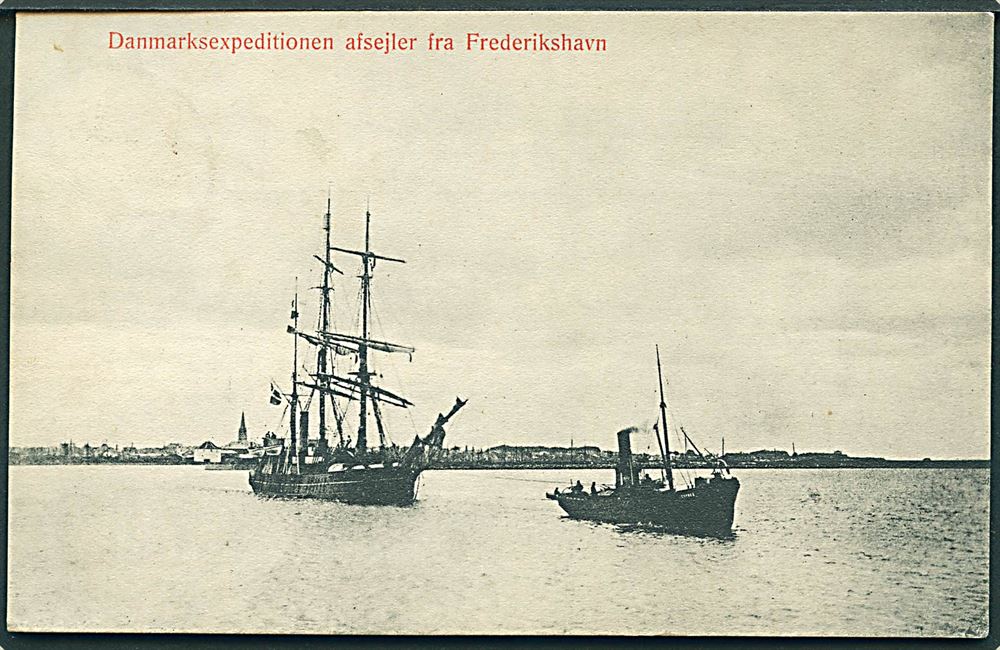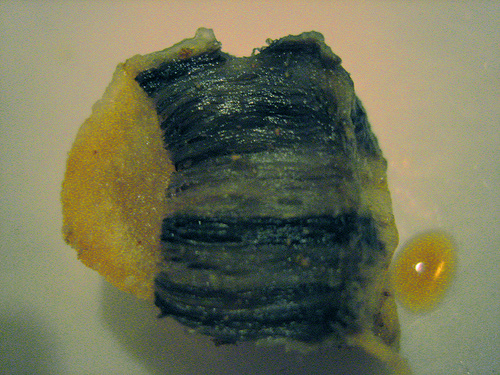|
Danmark (expedition Ship)
The bark ''Danmark'' is best known for her role as expedition ship for the Danmark expedition (1906–08), so named after the ship, but had a long prehistory as a whaler under the name ''Sir Colin Campbell'' of Peterhead and later as a sealer named ''Magdalena'' of Tønsberg/ Kristiana. The ship was built in Sunderland, England in 1855, rigged as a three-masted steam bark and originally fitted with a 98 hp high pressure steam engine. She sailed under the name ''Sir Colin Campbell'' on whaling trips from Scotland to the Greenland Sea and Davis Strait. In 1892 she was sold to Norway, refitted with a 200 hp triple expansion engine, renamed ''Magdalena'' and sailed as a seal catcher until 1906. The later polar explorer Roald Amundsen sailed on ''Magdalena'' in 1884 on a seal hunt into the West Ice. From the records of the oil factory of J.A. Nielson in Tønsberg it is reported that ''Magdalena'', owned by Gustav C. Hansen, was the first ship to process blubber at t ... [...More Info...] [...Related Items...] OR: [Wikipedia] [Google] [Baidu] |
Danmarkshavn
Danmarkshavn (Denmark's Harbour) is a small weather station located in Dove Bay, on the southern shore of the Germania Land Peninsula, in Northeast Greenland National Park, Greenland. History The location was chosen as a suitable winter harbor by the Denmark expedition in 1906 for their ship ''Danmark''. It became the main base of the expedition, from where sledge journeys and scientific observations were carried out. Description The permanent population of the base is six. Danmarkshavn is also known as the northernmost location on the coast of the Greenland Sea that non-icebreaking vessels can pass through. Therefore, it is resupplied by cargo ship in August every other year; thus the population increases somewhat for a brief time every other August. The ice situation varies, and some years it is not possible to reach the station, other years it is ice-free further north. It is operated by ''TELE-POST Greenland'', a telecommunications company. Danmarkshavn has a short airstri ... [...More Info...] [...Related Items...] OR: [Wikipedia] [Google] [Baidu] |
Whaler
A whaler or whaling ship is a specialized vessel, designed or adapted for whaling: the catching or processing of whales. Terminology The term ''whaler'' is mostly historic. A handful of nations continue with industrial whaling, and one, Japan, still dedicates a single factory ship for the industry. The vessels used by aboriginal whaling communities are much smaller and are used for various purposes over the course of the year. The ''whale catcher'' was developed during the age of steam, and then driven by diesel engines throughout much of the twentieth century. It was designed with a harpoon gun mounted at its bow and was fast enough to chase and catch rorquals such as the fin whale. At first, whale catchers either brought the whales they killed to a whaling station, a settlement ashore where the carcasses could be processed, or to its factory ship anchored in a sheltered bay or inlet. With the later development of the slipway at the ship's stern, whale catchers were able ... [...More Info...] [...Related Items...] OR: [Wikipedia] [Google] [Baidu] |
Danish Expedition Fund
Danish may refer to: * Something of, from, or related to the country of Denmark People * A national or citizen of Denmark, also called a "Dane," see Demographics of Denmark * Culture of Denmark * Danish people or Danes Danes ( da, danskere, ) are a North Germanic ethnic group and nationality native to Denmark and a modern nation identified with the country of Denmark. This connection may be ancestral, legal, historical, or cultural. Danes generally regard t ..., people with a Danish ancestral or ethnic identity * A member of the Danes (Germanic tribe), Danes, a Germanic tribe * Danish (name), a male given name and surname Language * Danish language, a North Germanic language used mostly in Denmark and Northern Germany * Danish tongue or Old Norse, the parent language of all North Germanic languages Food * Danish cuisine * Danish pastry, often simply called a "Danish" See also * Dane (other) * * Gdańsk * List of Danes * Languages of Denmark {{disambi ... [...More Info...] [...Related Items...] OR: [Wikipedia] [Google] [Baidu] |
Bass Rock (Greenland)
The Bass Rock, or simply the Bass (), ( gd, Creag nam Bathais or gd, Am Bas) is an island in the outer part of the Firth of Forth in the east of Scotland. Approximately offshore, and north-east of North Berwick, it is a steep-sided volcanic rock, at its highest point, and is home to a large colony of gannets. The rock is uninhabited, but historically has been settled by an early Christian hermit, and later was the site of an important castle, which after the Commonwealth of England, Commonwealth period was used as a prison. The island belongs to Hamilton-Dalrymple baronets, Hew Hamilton-Dalrymple, whose family acquired it in 1706, and before to the Lauder family for almost six centuries. The Bass Rock Lighthouse was constructed on the rock in 1902, and the remains of an ancient chapel survive. The Bass Rock features in many works of fiction, including ''Catriona (novel), Catriona'' by Robert Louis Stevenson, ''The Lion Is Rampant'' by the List of Scottish novelists, Scotti ... [...More Info...] [...Related Items...] OR: [Wikipedia] [Google] [Baidu] |
Shannon Island
Shannon Island ( da, Shannon Ø) is a large island in Northeast Greenland National Park in eastern Greenland, to the east of Hochstetter Foreland, with an area of . It was named by Douglas Charles Clavering on his 1823 expedition for the Royal Navy frigate HMS ''Shannon'', a 38 gun frigate on which he served as midshipman under Sir Philip Broke. The island is also home to many different types of animals such as polar bears, walruses, ravens, and oxen. History Most landmarks in the area were named by the Second German Polar Expedition under Carl Koldewey in 1869–70. Between October 1943 and June 1944, the German meteorological expedition ''Bassgeiger'' operated under difficult conditions at Kap Sussi on Shannon. Their ship ''Coburg'' was wrecked off Shannon. The station was discovered by hunters, but the crew was evacuated by air to Norway. The island is the site of several hunter's cabins and is reputed to have especially favorable ice conditions. Geography Shannon Island ... [...More Info...] [...Related Items...] OR: [Wikipedia] [Google] [Baidu] |
Blubber
Blubber is a thick layer of vascularized adipose tissue under the skin of all cetaceans, pinnipeds, penguins, and sirenians. Description Lipid-rich, collagen fiber-laced blubber comprises the hypodermis and covers the whole body, except for parts of the appendages. It is strongly attached to the musculature and skeleton by highly organized, fan-shaped networks of tendons and ligaments, can comprise up to 50% of the body mass of some marine mammals during some points in their lives, and can range from thick in dolphins and smaller whales, to more than thick in some bigger whales, such as right and bowhead whales. However, this is not indicative of larger whales' ability to retain heat better, as the thickness of a whale's blubber does not significantly affect heat loss. More indicative of a whale's ability to retain heat is the water and lipid concentration in blubber, as water reduces heat-retaining capacities, and lipid increases them. Function Blubber is the primary fat st ... [...More Info...] [...Related Items...] OR: [Wikipedia] [Google] [Baidu] |
West Ice
The West Ice is a patch of the Greenland Sea covered by pack ice during winter time. It is located north of Iceland, between Greenland and Jan Mayen island. The West Ice is a major breeding ground for seals, especially harp seals and hooded seals. It was discovered in the early 18th century by British whalers. At the time, whalers were not interested in seal hunting as long as there was ample stock of bowhead whales in the area. However, after the 1750s, the whale population had been depleted in the area, and systematic seal hunting started, first by British ships and then by German, Dutch, Danish, Norwegian, and Russian ships. The annual catches were 120,000 animals around 1900, mostly by Norway and Russia, and rose to 350,000 by the 1920s. They then declined, first because of imposed restrictions on total allowable catch and then in response to decreasing market demand. Nevertheless, the seal population in the West Ice was rapidly falling, from an estimated 1,000,000 in 1956 ... [...More Info...] [...Related Items...] OR: [Wikipedia] [Google] [Baidu] |
Roald Amundsen
Roald Engelbregt Gravning Amundsen (, ; ; 16 July 1872 – ) was a Norwegian explorer of polar regions. He was a key figure of the period known as the Heroic Age of Antarctic Exploration. Born in Borge, Østfold, Norway, Amundsen began his career as a polar explorer as first mate on Adrien de Gerlache's Belgian Antarctic Expedition of 1897–1899. From 1903 to 1906, he led the first expedition to successfully traverse the Northwest Passage on the sloop ''Gjøa''. In 1909, Amundsen began planning for a South Pole expedition. He left Norway in June 1910 on the ship ''Fram'' and reached Antarctica in January 1911. His party established a camp at the Bay of Whales and a series of supply depots on the Barrier (now known as the Ross Ice Shelf) before setting out for the pole in October. The party of five, led by Amundsen, became the first to successfully reach the South Pole on 14 December 1911. Following a failed attempt in 1918 to reach the North Pole by traversing the ... [...More Info...] [...Related Items...] OR: [Wikipedia] [Google] [Baidu] |
Davis Strait
Davis Strait is a northern arm of the Atlantic Ocean that lies north of the Labrador Sea. It lies between mid-western Greenland and Baffin Island in Nunavut, Canada. To the north is Baffin Bay. The strait was named for the English explorer John Davis (1550–1605), who explored the area while seeking a Northwest Passage. By the 1650s it was used for whale hunting. Extent The International Hydrographic Organization defines the limits of the Davis Strait as follows: ''On the North.'' The Southern limit of Baffin Bay 70° North between Greenland and Baffin Island">Baffin Land]. ''On the East.'' The Southwest coast of Greenland. ''On the South.'' The parallel of 60th parallel north, 60° North between Greenland and Labrador. ''On the West.'' The Eastern limit of the Northwestern Passages South of 70° North he East coast of Baffin Island to East Bluff, its Southeastern extremityand of Hudson Strait line from East Bluff, the Southeast extreme of Baffin Island (), to Point ... [...More Info...] [...Related Items...] OR: [Wikipedia] [Google] [Baidu] |
Greenland Sea
The Greenland Sea is a body of water that borders Greenland to the west, the Svalbard archipelago to the east, Fram Strait and the Arctic Ocean to the north, and the Norwegian Sea and Iceland to the south. The Greenland Sea is often defined as part of the Arctic Ocean, sometimes as part of the Atlantic Ocean. However, definitions of the Arctic Ocean and its seas tend to be imprecise or arbitrary. In general usage the term "Arctic Ocean" would exclude the Greenland Sea. In oceanographic studies the Greenland Sea is considered part of the Nordic Seas, along with the Norwegian Sea. The Nordic Seas are the main connection between the Arctic and Atlantic oceans and, as such, could be of great significance in a possible shutdown of thermohaline circulation. In oceanography the Arctic Ocean and Nordic Seas are often referred to collectively as the "Arctic Mediterranean Sea", a marginal sea of the Atlantic. The sea has Arctic climate with regular northern winds and temperatures rarely ... [...More Info...] [...Related Items...] OR: [Wikipedia] [Google] [Baidu] |






